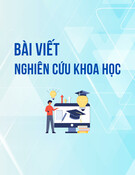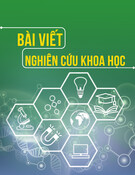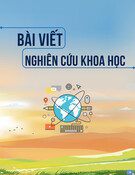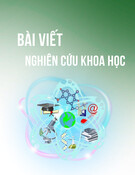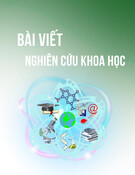
45
HUNG VUONG UNIVERSITY JOURNAL OF SCIENCE AND TECHNOLOGY Vol. 37, No. 4 (2024): 45 - 55
*Email: ngothithanhtu@hvu.edu.vn
TẠP CHÍ KHOA HỌC VÀ CÔNG NGHỆ
TRƯỜNG ĐẠI HỌC HÙNG VƯƠNG
Tập 37, Số 4 (2024): 45 - 55
HUNG VUONG UNIVERSITY
JOURNAL OF SCIENCE AND TECHNOLOGY
Vol. 37, No. 4 (2024): 45 - 55
Email: tapchikhoahoc@hvu.edu.vn Website: www.hvu.edu.vnjst.hvu.vn
DEVELOPING DIGITAL COMPETENCE FOR STUDENTS IN THE
CONTEXT OF THE FOURTH INDUSTRIAL REVOLUTION AT THE
FACULTY OF ECONOMICS AND BUSINESS ADMINISTRATION -
HUNG VUONG UNIVERSITY
Ngo Thi Thanh Tu1*
1Faculty of Economics and Business Administration, Hung Vuong University, Phu Tho
Received: 02 December 2024; Revised: 17 December 2024; Accepted: 19 December 2024
DOI: https://doi.org/10.59775/1859-3968.249
Abstract
This study explores digital competence development among students at the Faculty of Economics and
Business Administration, Hung Vuong University, in the context of the Fourth Industrial Revolution.
Using surveys and statistical analyses, it evaluates skills in information management, communication, content
creation, safety, and problem-solving. Results show strengths in foundational skills but challenges in content
creation and emerging technologies. The study highlights the need for curriculum updates, faculty training, and
industry collaboration to enhance competencies, contributing to discussions on workforce development aligned
with global economic demands.
Keywords: Digital competence, digital competence framework, students.
1. Introduction
The formation and development of digital
competence, as well as an understanding
of digital transformation, for students of
the Faculty of Economics and Business
Administration at Hung Vuong University,
is an inevitable requirement in today’s
digital era. Digital competence serves as
the key for individuals to develop their
potential in living, learning, working, and
achieving success. Developing digital
competence for students of the Faculty of
Economics and Business Administration
is an investment in building a high-quality
workforce for the future. This effort aims
to meet the ever-increasing demands of the
domestic and international labor markets
while shaping a new generation of global
citizens equipped with digital knowledge,
skills, and adaptability. Such competence
enhances productivity, improves the quality
of labor, unlocks the potential of science and
technology, elevates the quality of education

46
HUNG VUONG UNIVERSITY JOURNAL OF SCIENCE AND TECHNOLOGY Ngo Thi Thanh Tu
and training, and fosters the socio-economic
development of the nation.
In the digital era, knowledge is power,
and digital competence is the key to
unlocking the doors of knowledge. In a
world where information is transmitted
rapidly, each “click” or swipe of the screen
unveils a new era of learning. Amidst this
vast sea of information, the ability to select,
evaluate, and creatively utilize information
has become increasingly critical. Digital
skills go beyond the mere ability to use
technological tools. They empower us to
build critical thinking, distinguish truth from
misinformation, and differentiate between
truly valuable knowledge and content that
serves only entertainment purposes. We
must not only learn how to “live” in the
digital world but also learn how to “live
well,” leveraging the conveniences it
offers while protecting ourselves from its
negative impacts. This is why digital skills
extend beyond technological proficiency;
they encompass the development of digital
ethics, critical thinking, and information
management capabilities. Digital
transformation is an inevitable “wave” of our
time. Faced with the pressure of adapting to
technological advancements and evolving
societal demands, students of the Faculty
of Economics and Business Administration
must, in addition to mastering foundational
knowledge from their academic curriculum,
proactively enhance their social awareness
and learn to effectively apply advanced
technologies. This readiness enables them to
face the “wave” of digital transformation with
confidence. Developing digital competence
is a vital preparation for students in this new
economic era, empowering them to uncover
true values that contribute to their personal
growth and community development.
2. Digital competence and the
digital competence framework
for students
2.1. Digital competence
Digital competence is a broad concept
introduced in policy documents, research, and
increasingly emphasized in higher education.
UNESCO defines digital competence as
the ability to access, manage, understand,
integrate, communicate, evaluate, and
create information safely and appropriately
through digital technology to accomplish
tasks ranging from simple to complex and
even entrepreneurial endeavors. According
to UNESCO (2018), digital competence
encompasses computer skills, IT proficiency,
information literacy, and communication
abilities. This definition forms the
foundational framework for developing the
competency framework in this study [1].
On an individual level, digital
competence equips individuals to live,
learn, and work effectively in a digital
society. On an organizational level, it
extends beyond individual capabilities to
consider how the culture and infrastructure
of an organization can support and promote
digital activities. Simply put, digital
competence is the ability to understand,
utilize, and leverage information and
communication technology (ICT) to
achieve personal and professional
goals while creating value for society.
It encompasses a wide range of skills,
from basic ones such as using computers
and the internet to advanced skills like
programming, data analysis, artificial
intelligence (AI), machine learning, and
other cutting-edge digital technologies for
information acquisition, comprehension,
and intelligent decision-making.

47
HUNG VUONG UNIVERSITY JOURNAL OF SCIENCE AND TECHNOLOGY Vol. 37, No. 4 (2024): 45 - 55
In today’s world, where technology is
integrated into every aspect of life, digital
competence has become increasingly
important. It requires continuous learning
and adaptability to changes in technology and
the business environment. Both individuals
and organizations must possess diverse
digital skills to remain competitive and
thrive in the era of digitalization. Students
and learners today are growing up in an
environment enriched by modern technology
[2]. Contemporary students can create and
manage content, handle information, utilize
communication tools, and solve technological
problems, making them more competent
and competitive in meeting current societal
demands [3]. Additionally, the COVID-19
pandemic has accelerated innovation in
education, significantly affecting learning
models and teaching philosophies. As the
primary stakeholders in education, students
need to be equipped with digital skills to face
new challenges [4]. However, most students
lack the necessary level of digital skills
[5, 6]. Technology has not yet been fully
integrated into teaching processes, whether in
classrooms or online learning environments.
Although some studies have highlighted
students’ notable abilities in certain areas of
digital skills, there is still a long way to go
before they can achieve full mastery.
2.2. Digital competence framework for
students
In recent years, digital competence in
education has been evaluated from various
aspects and perspectives [7]. The European
Digital Competence Framework (DigComp)
has been widely adopted to support strategic
planning, policy development, educational
and training initiatives, and the assessment
of digital competencies [6]. The European
Commission first introduced the DigComp
framework in 2013 as a guideline for the
use and adaptation of digital competencies,
identifying the key components of digital
competence, including knowledge, skills,
and attitudes related to digital technology.
In 2016, the updated version, DigComp
2.0, was launched to address new demands
arising from the rapid digitalization of all
societal domains. This version revised and
updated the descriptions of competencies
and their key dimensions. DigComp 2.0
encompasses 21 competencies grouped into
five main dimensions: Information and data
literacy; Communication and collaboration;
Digital content creation; Safety; Problem-
solving. The subsequent version, DigComp
2.1, introduced eight proficiency levels for
competency measurement and provided
new usage examples. These specific
competencies, categorized under each major
dimension, were also restructured to place
less emphasis on the technical aspects of
operations and instead focus on applying
technology in practical contexts. This
shift highlights attitudes, empathy, critical
thinking, problem-solving, and innovation,
aligning with the broader objectives of
fostering creativity and adaptability in real-
world applications of technology.
The five aspects of digital competence
and the 21 specific competences identified
in the DigComp 2.0 framework provide a
comprehensive understanding of the digital
skills required in today’s modern society.
Within each aspect of digital competence,
there is a range of related specific
competences.

48
HUNG VUONG UNIVERSITY JOURNAL OF SCIENCE AND TECHNOLOGY Ngo Thi Thanh Tu
Table 1. Summary description of the digital competency framework according
to the DigComp 2.0 model
No Competency
group Description of competencies
1Information and
data capacity
1.1. Browsing, searching and filtering data, information and digital content
1.2. Evaluating data, information and digital content
1.3. Managing data, information and digital content
2Communication
and collaboration
2.1. Interacting through digital technology
2.2. Sharing through digital technology
2.3. Performing citizen roles and rights through digital technology
2.4. Collaborating through digital technology
2.5. Online behavior culture
2.6. Managing digital identities
3Digital content
creation
3.1. Developing digital content
3.2. Integrating and recycling digital content
3.3. Copyright and licensing
3.4. Programming
4 Safety assurance
4.1. Protecting devices
4.2. Protecting personal data and privacy
4.3. Protecting health and well-being
4.4. Protecting the environment
5 Problem solving
5.1. Solving technical problems
5.2. Identifying Technology Needs and Responses
5.3. Innovative Use of Digital Technology
5.4. Identifying Digital Capability Gaps
Source: Joint Research Center (JRC), European Commission
3. Results and Discussion
3.1. Survey description
- Survey sample: The survey was conducted
with a total of 1,129 students from the fields
of Accounting, Finance and Banking, Business
Administration, and Economics. The sample
was selected using the stratified random
sampling method, ensuring that the proportion
of surveyed students corresponds to the
number of students in each major. This method
reflects the characteristics and structure of
the entire student body [8]. It ensures equal
representation for each major and accurately
captures the reality of digital competency
development among different student groups.
- Data collection: A questionnaire was
developed to assess students’ perceptions
of their digital competency (comprising 34
questions) categorized into five competency
groups. A 5-point Likert scale was used for
students to evaluate their perceptions of
various aspects of digital competency. The
survey was distributed through class groups
on social media platforms (Zalo, Facebook,
MS Teams) to facilitate access and responses.
Each student took approximately 15-20
minutes to complete the questionnaire. In
total, 30% of students (equivalent to 339
students) were invited to participate in
the survey, ensuring a sufficiently large
sample size for statistical analysis with high
reliability [9].
- Data processing: The collected data were
processed and analyzed using Microsoft
Excel. Descriptive statistics, including
proportions, were calculated to evaluate
factors related to digital competency.

49
HUNG VUONG UNIVERSITY JOURNAL OF SCIENCE AND TECHNOLOGY Vol. 37, No. 4 (2024): 45 - 55
3.2. Survey results and discussions
3.2.1. Results of training information and
data capacity
In the booming era of the Internet,
information searching has gradually become
one of the essential skills demanded by
employers. The digital era has facilitated
the posting and updating of information,
creating numerous opportunities for
accessing resources. Consequently, the
training of students from the Faculty of
Economics & Business Administration
in effective information searching skills
has been integrated into various courses
through activities such as group discussions,
essays, and major assignments. Additionally,
students are encouraged to search for
information in English, enabling them to
access a wider range of data sources and
gather more information to support their
objectives.
Table 2. Students’ feelings about digital competencies for information and data aspects
No Information and data capacity
Rate of evaluation by level (%)
Very
weak Weak Average Good Very
good
1
Use information technology to search, select, organize,
evaluate, process, store, transform, disseminate and
communicate information.
0 1 36 52 11
2
Use specialized search engines (Google, Bing, Yahoo,
ChatGPT, Gemini ...) with different methods (identify
keywords, synonyms and related terms, search in
multiple languages ...).
0 2 22 62 14
3
Know different sources of information and be able to
build reasonable search strategies depending on the
source of information.
0 2 34 52 12
4
Analyze and criticize information, information sources,
digital content, verify the validity and timeliness of
information found.
1 1 45 42 11
5
Apply different methods and tools to manage and store
information, data, digital content for easy retrieval when
needed.
1 1 36 50 12
6Have a personal strategy to organize, manage and
retrieve information and data. 1 3 40 44 12
Source: Survey results, November 2024.
From Table 2, it can be observed that
students demonstrate a fairly strong ability
to use information technology for searching,
storing, organizing, and communicating data,
with 62% rating their skills as “good” or “very
good”. This indicates students’ familiarity
with tools that support data processing in
learning and work contexts. Their ability to
use search engines (Google, Bing, ChatGPT,
etc.) and advanced methods such as keyword
identification and multilingual searching is
also rated positively, with 56% of students
assessing their skills as “good” or “very
good”. This reflects students’ competence
in effectively and diversely utilizing
information. Students also show a relatively
high level of critical thinking and the ability
to evaluate the authenticity and relevance of
information, with 56% giving themselves
a “good” or “very good” rating. This is a
critical skill, especially in the increasingly
complex and multidimensional information
landscape of the digital age. Moreover, 53%
of students rate their ability to apply digital
methods and tools for organizing, analyzing,
and extracting data as “good” or “very

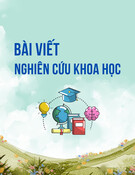
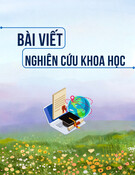
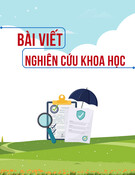
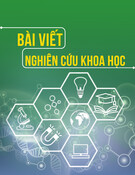
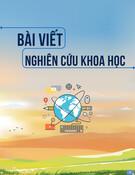
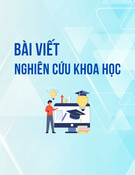

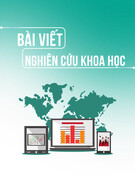
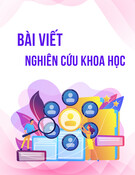
![Đào tạo kiến trúc sư kỷ nguyên số: Hướng tiếp cận từ chương trình đào tạo [mới nhất]](https://cdn.tailieu.vn/images/document/thumbnail/2025/20251218/kimphuong1001/135x160/29341766042045.jpg)
